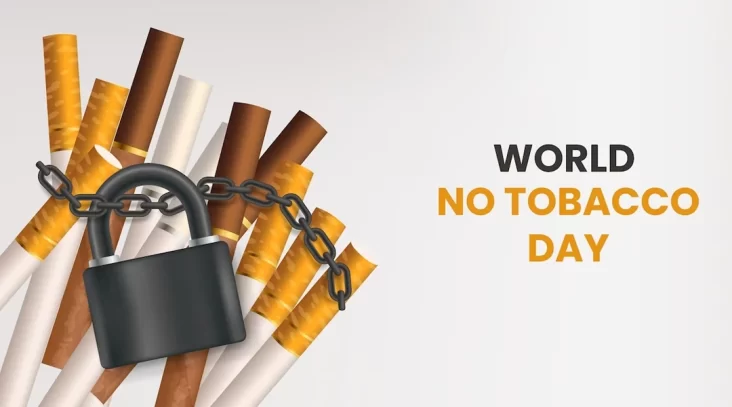On May 31, people from all over the world get together to spread awareness of the harmful effects of tobacco use. Anti-Tobacco Day or World No Tobacco Day are observed on this day. Tobacco is a dangerous chemical that has contributed to a number of illnesses and disorders throughout the world. It poses a significant danger for a number of illnesses, such as lung cancer, heart disease, stroke, and respiratory disorders.
The World Health Organisation (WHO) estimates that tobacco use kills about 8 million people worldwide each year. We’ll talk about the link between cigarette use and bad health in this blog.
What is Tobacco?
In order to manufacture tobacco products like cigarettes, cigars, and chewing tobacco, the tobacco plant is grown for its leaves, which are then dried and processed. Nicotine, the main psychoactive component of tobacco, is extremely addictive and can cause dependency and withdrawal symptoms.
How Does Tobacco Harm Our Health?
The use of tobacco has been associated with a number of illnesses, including cancer, heart disease, stroke, respiratory diseases, and problems with reproduction. The numerous poisonous compounds found in tobacco, such as tar, carbon monoxide, and formaldehyde, among others, are what cause its negative consequences. These substances can harm the heart, lungs, and other organs and increase the risk of developing chronic illnesses.
Smoking and Cancer
Smoking increases the risk of developing several cancers, including lung, throat, oesophageal, bladder, and pancreatic cancer. Toxic substances in tobacco smoke can harm cells’ DNA, which over time may result in the emergence of cancer.
Smoking and Heart Disease
Another significant risk factor for heart disease is smoking. Toxic substances included in cigarette smoke can harm blood vessels, which can result in plaque accumulation and artery narrowing. This could make heart attacks, strokes, and other cardiovascular issues more likely.
Smoking and Respiratory Disorders
Smoking can also result in a number of respiratory conditions, including emphysema and chronic obstructive pulmonary disease (COPD). The harmful substances in tobacco smoke can damage and inflame the lungs, which can result in breathing problems and other respiratory issues.
Smoking and its Effects on the Cardiovascular System
The cardiovascular system is significantly impacted by tobacco usage as well. Heart disease and stroke, two of the world’s leading causes of death, are made more likely by smoking.
When tobacco is smoked, it briefly raises blood pressure and heart rate. The blood arteries may suffer harm as a result over time, becoming less flexible and more prone to obstructions. This can result in atherosclerosis, a condition where artery plaque clogs and reduces blood flow. Heart attacks, strokes, and other severe health issues can be brought on by atherosclerosis.
Smoking and its Effects on Oral Health
Oral health can also be harmed by tobacco usage. Smoking can result in gum disease, discoloured teeth, and foul breath. Snuff and other smokeless tobacco products, like chewing tobacco, can lead to mouth cancer and other health issues.
Smoking and its Effects on Reproductive Health
The use of tobacco can be detrimental to reproductive health. Smokers are more likely to have trouble getting pregnant and are more likely to experience difficulties with their pregnancies, such as premature labour and low birth weight. The risk of sudden infant death syndrome (SIDS) can also rise when a pregnant woman smokes.
Smoking and its Effects on Mental Health
Anxiety and sadness, as well as other mental health issues, have been related to tobacco usage. The addictive component of tobacco, nicotine, can modify the chemistry of the brain, impacting one’s mood and behaviours. It can be difficult to stop smoking, and many people endure uncomfortable withdrawal symptoms like irritability, anxiety, and despair.
The Dangers of Secondhand Smoke
Secondhand smoke, commonly referred to as passive smoking or environmental tobacco smoke, is a serious health risk to both people who use tobacco and those in close proximity to them. This kind of cigarette smoke exposure can harm your health in many ways and raise your risk of getting serious illnesses.
Respiratory conditions like bronchitis and asthma might develop as a result of breathing in this contaminated air. Additionally, it may be a factor in heart disease, stroke, and lung conditions like emphysema and chronic obstructive pulmonary disease (COPD).
Children’s developing lungs make them especially susceptible to the risks of secondhand smoke. SIDS, ear infections, coughing fits, and even missed school due to illness can all result from exposure.
How Can You Quit Smoking?
Although giving up smoking can be difficult, it is doable with the correct resources and assistance. Among the most successful techniques to stop smoking are:
Nicotine replacement therapy: To treat cravings and withdrawal symptoms, products like nicotine gum, patches, or lozenges are used.
Medications: The withdrawal symptoms and cravings that come with quitting smoking might be lessened with the aid of some drugs.
Counselling and support groups: Joining a support group or counselling session can offer both emotional support and helpful tips for stopping smoking.
Lifestyle changes: Making healthy lifestyle adjustments including stopping smoking cigarettes, eating a balanced diet, and exercising frequently can also help.
Conclusion
Tobacco is a dangerous chemical that can lead to cancer, heart disease, and respiratory diseases, among other health issues. It’s critical to comprehend the link between tobacco use and health and to take action to cut back on or stop using cigarettes. This World No Tobacco Day you can enhance your health and lower your risk of getting chronic diseases by giving up smoking. To check your general health and get started living without cigarettes, schedule a blood test with Metropolis Labs now. You can beat the addiction and live a better life if you have the correct resources and assistance.


3 Comments
Pingback: World No Tobacco Day – Sujata Birla Hospital
Pingback: How To Stay Healthy And Fit As You Get Older | Mr. Yash Birla
Pingback: Psoriasis | Sujata Birla Hospital